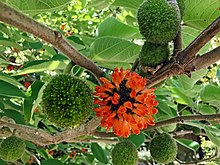| Broussonetia | |
|---|---|

| |
| Broussonetia papyrifera (paper mulberry) | |
| Scientific classification | |
| Kingdom: | Plantae |
| Clade: | Tracheophytes |
| Clade: | Angiosperms |
| Clade: | Eudicots |
| Clade: | Rosids |
| Order: | Rosales |
| Family: | Moraceae |
| Tribe: | Dorstenieae |
| Genus: | Broussonetia (L.) L'Hér. ex Vent. (1799) |
| Species[1] | |
| |
| Synonyms[1] | |
| |
Broussonetia is a genus of four species (including one hybrid species) of trees in the family Moraceae, native to eastern Asia.[1] These four species have high-quality fiber which consist of more than 90% of cellulose. They are traditionally applied for various daily necessities in South Eastern Asia and papermaking in East Asia.
One of these is the paper mulberry (Broussonetia papyrifera), whose bark fiber is used to make traditional paper in China, Korea, and Japan. This species has been widely introduced and has become invasive in some areas. Not only is paper mulberry used for paper making, but also other species are widely used in paper industry in those three countries' history. In fact, paper mulberry is not a major source of their traditional paper at least in Korea and Japan. Major material fibers of Hanji (Korean paper) and Washi (Japanese paper) come from Broussonetia × kazinoki.[2] Broussonetia × kazinoki is known as only hybrid in Broussonetia genus between B. monoica and B. papyrifera.
- ^ a b c "Broussonetia L'Hér. ex Vent. | Plants of the World Online | Kew Science". Plants of the World Online. Retrieved 22 April 2024.
- ^ Kuo, W. H., Liu, S. H., Chang, C. C., Hsieh, C. L., Li, Y. H., Ito, T., ... & Chung, K. F. (2022). "Plastome phylogenomics of Allaeanthus, Broussonetia and Malaisia (Dorstenieae, Moraceae) and the origin of B.× kazinoki". Journal of Plant Research: 1–18.
{{cite journal}}: CS1 maint: multiple names: authors list (link)